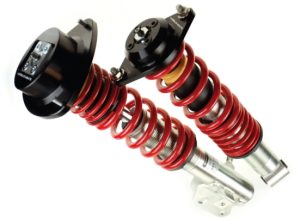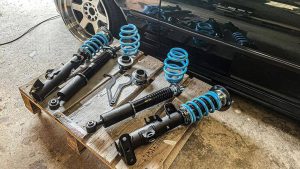When it comes to your car’s suspension system, few components have as significant an impact on ride quality, handling, and vehicle dynamics as the springs. Among the most debated choices in the world of suspension upgrades are coilover springs and conventional coil springs. Whether you’re looking to enhance daily comfort, improve cornering on the track, or simply replace worn-out parts, choosing the right spring setup is essential.
In this article, we’ll break down the differences, benefits, and use cases of coilover springs vs. conventional coil springs to help you determine which setup is best for your driving needs.
What Are Coil Springs and Coilovers?

Conventional Coil Springs
These are standalone springs found in most production vehicles. They’re typically mounted separately from the shock absorber, although sometimes combined in MacPherson strut setups.
Coilover Springs (and Coilovers)
A coilover is a spring and shock absorber combination unit, where the coil spring is wrapped around the shock body. The term “coilover” is short for “coil spring over shock.”
Key Differences at a Glance
| Feature | Conventional Coil Springs | Coilover Springs |
|---|---|---|
| Design | Standalone spring | Integrated with shock absorber |
| Adjustability | Fixed height & damping | Height and often damping adjustable |
| Installation complexity | Easier to install and replace | More complex installation |
| Ride customization | Limited | Highly customizable |
| Typical application | Daily drivers, OEM setups | Performance tuning, racing, lowered cars |
| Cost | Lower | Higher (especially premium coilovers) |
Benefits of Conventional Coil Springs
-
Simplicity and Reliability
Conventional springs are time-tested and durable. Ideal for drivers who want reliable performance without the need for adjustments. -
Cost-Effective
They are significantly cheaper than full coilover systems, both in terms of parts and labor. -
OEM Compatibility
Perfect replacement for factory setups, especially if you’re not modifying ride height or handling characteristics.
Benefits of Coilover Springs
-
Adjustable Ride Height
One of the biggest advantages — coilovers allow you to raise or lower your car to achieve the desired stance or clearance. -
Tunable Damping and Stiffness
Many coilovers allow adjustments to rebound and compression rates, enabling you to tune your suspension for daily driving or track use. -
Integrated Design
With spring and shock as one unit, coilovers are compact and precise, offering better feedback and handling response. -
Performance-Focused
Engineered for motorsport and enthusiasts, coilovers significantly improve handling, body roll, and cornering performance.
Which One Should You Choose?
The answer depends on your driving style, goals, and budget. Here’s a breakdown to help guide your decision:
| Driving Need | Best Option | Reason |
|---|---|---|
| Daily commuting | Conventional coil springs | Comfortable, simple, budget-friendly |
| Long-distance touring | Conventional coil springs | Softer ride, better isolation |
| Aggressive street performance | Coilovers | Adjustable handling, better response |
| Track or competitive use | Coilovers | Precision, adjustability, superior grip |
| Lowering for aesthetics | Coilovers | Full control over ride height |
| Off-road or lifted setups | Coilovers or lift springs | Tailored damping and support |
Downsides to Consider
Coilover Springs:
-
Higher cost
-
More maintenance (especially adjustable types)
-
Complex installation
-
May be excessive for daily drivers
Conventional Coil Springs:
-
No adjustability
-
Less performance-oriented
-
Limited tuning capability
Real-World Scenarios
Scenario 1: You drive a commuter sedan and want to replace worn springs.
Choose: Conventional coil springs
Scenario 2: You own a sports coupe and want tighter handling for weekend drives.
Choose: Coilovers
Scenario 3: You’ve installed larger wheels and want to avoid tire rubbing.
Choose: Coilovers
Coilover vs. Conventional Spring Maintenance
| Aspect | Coilover Springs | Conventional Coil Springs |
|---|---|---|
| Wear and Tear | Shocks and springs wear together | Replace springs or shocks separately |
| Service Interval | Clean and inspect regularly | Typically every 100,000 km |
| Rust Protection | Needed for thread protection | Standard coatings usually enough |
Summary: Coilover or Conventional?
| Feature | Coilover Springs | Conventional Coil Springs |
|---|---|---|
| Ideal for | Performance setups | Daily driving and comfort |
| Adjustability | Yes | No |
| Cost | Higher | Lower |
| Handling Performance | Excellent | Moderate |
| Ride Comfort | Moderate | Good |
| Installation Complexity | Higher | Lower |
| Maintenance | Medium | Low |
Final Thoughts

Both coilover and conventional coil springs offer specific benefits depending on your needs. If you’re chasing performance and adjustability, coilovers are the better option. For those prioritizing reliability, comfort, and cost-effectiveness, conventional coil springs are more practical.
Still unsure? Explore a wide selection of high-quality spring components at the link below:
Buy Springs & Components online